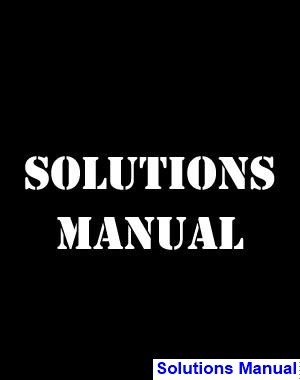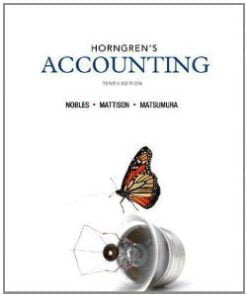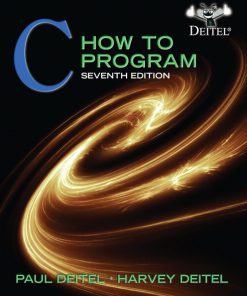Economics 1st Edition Acemoglu Solutions Manual
$35.00 Original price was: $35.00.$26.50Current price is: $26.50.
Economics 1st Edition Acemoglu Solutions Manual
This is completed downloadable of Economics 1st Edition Acemoglu Solutions Manual

Product Details:
- ISBN-10 : 0321391586
- ISBN-13 : 978-0321391582
- Author: Daron Acemoglu (Author), David Laibson (Author), John List (Author)
Acemoglu, Laibson, List: An evidence-based approach to economics
Throughout Economics, authors Daron Acemoglu, David Laibson, and John List use real economic questions and data to help students learn about the world around them.
Taking a fresh approach, the authors use the themes of optimization, equilibrium and empiricism to illustrate the power of simple economic ideas, and their ability to explain, predict, and improve what happens in the world. Each chapter begins with an empirical question that is later answered using data in the Evidence-Based Economics feature. As a result of the text’s practical emphasis, students will learn to apply economic principles to guide the decisions they make in their own lives.
Table of Content:
Contents Preface xv Part I: Introduction Chapter 1 Economic Growth and Economic Development: The Questions 3 1.1 Cross-Country Income Differences 3 1.2 Income and Welfare 7 1.3 Economic Growth and Income Differences 9 1.4 Origins of Today's Income Differences and World Economic Growth 11 1.5 Conditional Convergence 15 1.6 Correlates of Economic Growth 18 1.7 From Correlates to Fundamental Causes 19 1.8 The Agenda 21 1.9 References and Literature 23 Chapter 2 The Solow Growth Model 26 2.1 The Economic Environment of the Basic Solow Model 27 2.2 The Solow Model in Discrete Time 34 2.3 Transitional Dynamics in the Discrete-Time Solow Model 43 2.4 The Solow Model in Continuous Time 47 2.5 Transitional Dynamics in the Continuous-Time Solow Model 51 2.6 A First Look at Sustained Growth 55 2.7 Solow Model with Technological Progress 56 2.8 Comparative Dynamics 67 2.9 Taking Stock 68 2.10 References and Literature 69 2.11 Exercises 71 Chapter 3 The SolowModel and the Data 77 3.1 Growth Accounting 77 3.2 The Solow Model and Regression Analyses 80 3.3 The Solow Model with Human Capital 85 vii Acemoglu first pages 2008/8/24 11:21 p. vii (front) Princeton Editorial Assoc., JRS ZzTEX 13.6 viii . Contents 3.4 Solow Model and Cross-Country Income Differences: Regression Analyses 90 3.5 Calibrating Productivity Differences 96 3.6 Estimating Productivity Differences 100 3.7 Taking Stock 105 3.8 References and Literature 106 3.9 Exercises 107 Chapter 4 Fundamental Determinants of Differences in Economic Performance 109 4.1 Proximate versus Fundamental Causes 109 4.2 Economies of Scale, Population, Technology, and World Growth 112 4.3 The Four Fundamental Causes 114 4.4 The Effect of Institutions on Economic Growth 123 4.5 What Types of Institutions? 136 4.6 Disease and Development 137 4.7 Political Economy of Institutions: First Thoughts 140 4.8 Taking Stock 140 4.9 References and Literature 141 4.10 Exercises 143 Part II: Toward Neoclassical Growth Chapter 5 Foundations of Neoclassical Growth 147 5.1 Preliminaries 147 5.2 The Representative Household 149 5.3 Infinite Planning Horizon 156 5.4 The Representative Firm 158 5.5 Problem Formulation 160 5.6 Welfare Theorems 161 5.7 Proof of the Second Welfare Theorem (Theorem 5.7)* 168 5.8 Sequential Trading 171 5.9 Optimal Growth 174 5.10 Taking Stock 176 5.11 References and Literature 176 5.12 Exercises 178 Chapter 6 Infinite-Horizon Optimization and Dynamic Programming 182 6.1 Discrete-Time Infinite-Horizon Optimization 182 6.2 Stationary Dynamic Programming 185 6.3 Stationary Dynamic Programming Theorems 187 6.4 The Contraction Mapping Theorem and Applications* 190 6.5 Proofs of the Main Dynamic Programming Theorems* 194 6.6 Applications of Stationary Dynamic Programming 201 6.7 Nonstationary Infinite-Horizon Optimization 211 6.8 Optimal Growth in Discrete Time 215 6.9 Competitive Equilibrium Growth 219 Acemoglu first pages 2008/8/24 11:21 p. viii (front) Princeton Editorial Assoc., JRS ZzTEX 13.6 Contents . ix 6.10 Computation 221 6.11 Taking Stock 221 6.12 References and Literature 222 6.13 Exercises 223 Chapter 7 An Introduction to the Theory of Optimal Control 227 7.1 Variational Arguments 228 7.2 The Maximum Principle: A First Look 235 7.3 Infinite-Horizon Optimal Control 240 7.4 More on Transversality Conditions 250 7.5 Discounted Infinite-Horizon Optimal Control 253 7.6 Existence of Solutions, Concavity, and Differentiability* 259 7.7 A First Look at Optimal Growth in Continuous Time 268 7.8 The q-Theory of Investment and Saddle-Path Stability 269 7.9 Taking Stock 274 7.10 References and Literature 275 7.11 Exercises 278 Part III: Neoclassical Growth Chapter 8 The Neoclassical Growth Model 287 8.1 Preferences, Technology, and Demographics 287 8.2 Characterization of Equilibrium 293 8.3 Optimal Growth 298 8.4 Steady-State Equilibrium 300 8.5 Transitional Dynamics and Uniqueness of Equilibrium 302 8.6 Neoclassical Growth in Discrete Time 305 8.7 Technological Change and the Canonical Neoclassical Model 306 8.8 The Role of Policy 312 8.9 Comparative Dynamics 313 8.10 A Quantitative Evaluation 315 8.11 Extensions 317 8.12 Taking Stock 317 8.13 References and Literature 318 8.14 Exercises 319 Chapter 9 Growth with Overlapping Generations 327 9.1 Problems of Infinity 328 9.2 The Baseline Overlapping Generations Model 329 9.3 The Canonical Overlapping Generations Model 335 9.4 Overaccumulation and Pareto Optimality of Competitive Equilibrium in the Overlapping Generations Model 336 9.5 Role of Social Security in Capital Accumulation 339 9.6 Overlapping Generations with Impure Altruism 342 9.7 Overlapping Generations with Perpetual Youth 345 9.8 Overlapping Generations in Continuous Time 348 9.9 Taking Stock 353 Acemoglu first pages 2008/8/24 11:21 p. ix (front) Princeton Editorial Assoc., JRS ZzTEX 13.6 x . Contents 9.10 References and Literature 354 9.11 Exercises 355 Chapter 10 Human Capital and Economic Growth 359 10.1 A Simple Separation Theorem 359 10.2 Schooling Investments and Returns to Education 361 10.3 The Ben-Porath Model 363 10.4 Neoclassical Growth with Physical and Human Capital 367 10.5 Capital-Skill Complementarity in an Overlapping Generations Model 371 10.6 Physical and Human Capital with Imperfect Labor Markets 374 10.7 Human Capital Externalities 379 10.8 The Nelson-Phelps Model of Human Capital 380 10.9 Taking Stock 382 10.10 References and Literature 384 10.11 Exercises 384 Chapter 11 First-Generation Models of Endogenous Growth 387 11.1 The AK Model Revisited 388 11.2 The AK Model with Physical and Human Capital 393 11.3 The Two-Sector AK Model 395 11.4 Growth with Externalities 398 11.5 Taking Stock 402 11.6 References and Literature 404 11.7 Exercises 404 Part IV: Endogenous Technological Change Chapter 12 Modeling Technological Change 411 12.1 Different Conceptions of Technology 411 12.2 Science and Profits 414 12.3 The Value of Innovation in Partial Equilibrium 416 12.4 The Dixit-Stiglitz Model and Aggregate Demand Externalities 422 12.5 Individual R&D Uncertainty and the Stock Market 428 12.6 Taking Stock 429 12.7 References and Literature 430 12.8 Exercises 431 Chapter 13 Expanding VarietyModels 433 13.1 The Lab-Equipment Model of Growth with Input Varieties 433 13.2 Growth with Knowledge Spillovers 444 13.3 Growth without Scale Effects 446 13.4 Growth with Expanding Product Varieties 448 13.5 Taking Stock 452 13.6 References and Literature 453 13.7 Exercises 453 Acemoglu first pages 2008/8/24 11:21 p. x (front) Princeton Editorial Assoc., JRS ZzTEX 13.6 Contents . xi Chapter 14 Models of Schumpeterian Growth 458 14.1 A Baseline Model of Schumpeterian Growth 459 14.2 A One-Sector Schumpeterian Growth Model 468 14.3 Innovation by Incumbents and Entrants 472 14.4 Step-by-Step Innovations* 479 14.5 Taking Stock 489 14.6 References and Literature 490 14.7 Exercises 491 Chapter 15 Directed Technological Change 497 15.1 Importance of Biased Technological Change 498 15.2 Basics and Definitions 500 15.3 Baseline Model of Directed Technological Change 503 15.4 Directed Technological Change with Knowledge Spillovers 514 15.5 Directed Technological Change without Scale Effects 518 15.6 Endogenous Labor-Augmenting Technological Change 519 15.7 Generalizations and Other Applications 522 15.8 An Alternative Approach to Labor-Augmenting Technological Change* 523 15.9 Taking Stock 526 15.10 References and Literature 527 15.11 Exercises 529 Part V: Stochastic Growth Chapter 16 Stochastic Dynamic Programming 537 16.1 Dynamic Programming with Expectations 537 16.2 Proofs of the Stochastic Dynamic Programming Theorems* 544 16.3 Stochastic Euler Equations 549 16.4 Generalization to Markov Processes* 552 16.5 Applications of Stochastic Dynamic Programming 554 16.6 Taking Stock 561 16.7 References and Literature 561 16.8 Exercises 562 Chapter 17 Stochastic Growth Models 566 17.1 The Brock-Mirman Model 567 17.2 Equilibrium Growth under Uncertainty 571 17.3 Application: Real Business Cycle Models 579 17.4 Growth with Incomplete Markets: The Bewley Model 583 17.5 The Overlapping Generations Model with Uncertainty 586 17.6 Risk, Diversification, and Growth 588 17.7 Taking Stock 603 17.8 References and Literature 604 17.9 Exercises 605 Acemoglu first pages 2008/8/24 11:21 p. xi (front) Princeton Editorial Assoc., JRS ZzTEX 13.6 xii . Contents Part VI: Technology Diffusion, Trade, and Interdependences Chapter 18 Diffusion of Technology 611 18.1 Productivity Differences and Technology 611 18.2 A Benchmark Model of Technology Diffusion 613 18.3 Technology Diffusion and Endogenous Growth 619 18.4 Appropriate and Inappropriate Technologies and Productivity Differences 623 18.5 Contracting Institutions and Technology Adoption 630 18.6 Taking Stock 642 18.7 References and Literature 643 18.8 Exercises 644 Chapter 19 Trade and Growth 648 19.1 Growth and Financial Capital Flows 648 19.2 Why Does Capital Not Flow from Rich to Poor Countries? 653 19.3 Economic Growth in a Heckscher-Ohlin World 655 19.4 Trade, Specialization, and the World Income Distribution 663 19.5 Trade, Technology Diffusion, and the Product Cycle 674 19.6 Trade and Endogenous Technological Change 678 19.7 Learning-by-Doing, Trade, and Growth 680 19.8 Taking Stock 684 19.9 References and Literature 685 19.10 Exercises 687 Part VII: Economic Development and Economic Growth Chapter 20 Structural Change and Economic Growth 697 20.1 Nonbalanced Growth: The Demand Side 697 20.2 Nonbalanced Growth: The Supply Side 703 20.3 Agricultural Productivity and Industrialization 715 20.4 Taking Stock 719 20.5 References and Literature 720 20.6 Exercises 721 Chapter 21 Structural Transformations and Market Failures in Development 725 21.1 Financial Development 726 21.2 Fertility, Mortality, and the Demographic Transition 729 21.3 Migration, Urbanization, and the Dual Economy 736 21.4 Distance to the Frontier and Changes in the Organization of Production 744 21.5 Multiple Equilibria from Aggregate Demand Externalities and the Big Push 752 21.6 Inequality, Credit Market Imperfections, and Human Capital 758 21.7 Toward a Unified Theory of Development and Growth? 764 21.8 Taking Stock 768 21.9 References and Literature 769 21.10 Exercises 771 Acemoglu first pages 2008/8/24 11:21 p. xii (front) Princeton Editorial Assoc., JRS ZzTEX 13.6 Contents . xiii Part VIII: The Political Economy of Growth Chapter 22 Institutions, Political Economy, and Growth 781 22.1 The Impact of Institutions on Long-Run Development 781 22.2 Distributional Conflict and Economic Growth in a Simple Society 784 22.3 The Canonical Cobb-Douglas Model of Distributional Conflict 792 22.4 Distributional Conflict and Competition 793 22.5 Subgame Perfect versus Markov Perfect Equilibria 799 22.6 Inefficient Economic Institutions: A First Pass 802 22.7 Heterogeneous Preferences, Social Choice, and the Median Voter* 805 22.8 Distributional Conflict and Economic Growth: Heterogeneity and the Median Voter 814 22.9 The Provision of Public Goods: Weak versus Strong States 817 22.10 Taking Stock 822 22.11 References and Literature 823 22.12 Exercises 825 Chapter 23 Political Institutions and Economic Growth 831 23.1 Political Regimes and Economic Growth 832 23.2 Political Institutions and Growth-Enhancing Policies 834 23.3 Dynamic Trade-offs 837 23.4 Understanding Endogenous Political Change 850 23.5 Taking Stock 856 23.6 References and Literature 857 23.7 Exercises 858 Epilogue Mechanics and Causes of Economic Growth 861 861What Have We Learned?864A Possible Perspective on Growth and Stagnation over the Past 200 Years872Many Remaining Questions Part IX: Mathematical Appendixes Appendix A Odds and Ends in Real Analysis and Applications to Optimization 877 A.1 Distances and Metric Spaces 878 A.2 Mappings, Functions, Sequences, Nets, and Continuity 880 A.3 A Minimal Amount of Topology: Continuity and Compactness* 885 A.4 The Product Topology* 889 A.5 Absolute Continuity and Equicontinuity* 891 A.6 Correspondences and Berge's Maximum Theorem 894 A.7 Convexity, Concavity, Quasi-Concavity, and Fixed Points 898 A.8 Differentiation, Taylor Series, and the Mean Value Theorem 900 A.9 Functions of Several Variables and the Inverse and Implicit Function Theorems904 A.10 Separation Theorems* 907 A.11 Constrained Optimization 910 A.12 Exercises 915 Acemoglu first pages 2008/8/24 11:21 p. xiii (front) Princeton Editorial Assoc., JRS ZzTEX 13.6 xiv . Contents Appendix B Review of Ordinary Differential Equations 917 B.1 Eigenvalues and Eigenvectors 917 B.2 Some Basic Results on Integrals 918 B.3 Linear Differential Equations 920 B.4 Solutions to Linear First-Order Differential Equations 921 B.5 Systems of Linear Differential Equations 924 B.6 Local Analysis and Stability of Nonlinear Differential Equations 926 B.7 Separable and Exact Differential Equations 927 B.8 Existence and Uniqueness of Solutions 929 B.9 Continuity and Differentiability of Solutions 930 B.10 Difference Equations 930 B.11 Exercises 932 Appendix C Brief Review of Dynamic Games 934 C.1 Basic Definitions 934 C.2 Some Basic Results 937 C.3 Application: Repeated Games with Perfect Observability 941 C.4 Exercises 942 Appendix D List of Theorems 944 944Chapter 2944Chapter 5944Chapter 6945Chapter 7945Chapter 10945Chapter 16946Chapter 22946Appendix A947Appendix B947Appendix C References 949 Index Preface As long as a branch of science offers an abundance of problems, so long is it alive. -David Hilbert, Paris, 1900 This book is intended to serve two purposes. First and foremost, this is a book about economic growth and long-run economic development. The process of economic growth and the sources of differences in economic performance across nations are some of the most interesting, important and challenging areas in modern social science. The primary purpose of this book is to introduce graduate students to these major questions and to the theoretical tools necessary for studying them. The book therefore strives to provide students with a strong background in dynamic economic analysis, since only such a background will enable a serious study of economic growth and economic development. I also try to provide a clear discussion of the broad empirical patterns and historical processes underlying the current state of the world economy. This narrative is motivated by my belief that to understand why some countries grow and others fail to do so, economists have to move beyond the mechanics of models and pose questions about the fundamental causes of economic growth. Second, In a somewhat different capacity, this book is also a graduate-level introduction to modern macroeconomics and dynamic economic analysis. It is sometimes commented that, unlike basic microeconomic theory, there is no core of current macroeconomic theory that is shared by all economists. This is not entirely true. While there is disagreement among macroeconomists about how to approach short-run macroeconomic phenomena and what the boundaries of macroeconomics should be, there is broad agreement about the workhorse models of dynamic macroeconomic analysis. These include the Solow growth model, the neoclassical growth model, the overlapping generations model, and models of technological change and technology adoption. Since these are all models of economic growth, a thorough treatment of modern economic growth can also provide (and perhaps should provide) an introduction to this core material of modern macroeconomics. Although there are several good graduate-level macroeconomic textbooks, they typically spend relatively little time on the basic core material and do not develop the links between modern macroeconomic analysis and economic dynamics on the one hand and general equilibrium theory on the other. In contrast, the current book does not cover any of the short-run topics in macroeconomics, but provides a thorough and rigorous introduction to what I view to be the core of macroeconomics. The selection of topics is designed to strike a balance between the two purposes of the book. Chapters 1, 3, and 4 introduce many of the salient features of the process of economic growth and the sources of cross-country differences in economic performance. Even though these xv Acemoglu first pages 2008/8/24 11:21 p. xv (front) Princeton Editorial Assoc., JRS ZzTEX 13.6 xvi . Preface chapters cannot do justice to the large literature on economic growth empirics, they provide a sufficient background for students to appreciate the issues that are central to the study of economic growth and a platform for further study of this large literature. Chapters 5-7 cover the conceptual and mathematical foundations of modern macroeconomic analysis. Chapter 5 provides the microfoundations for much of the rest of the book (and for much of modern macroeconomics), while Chapters 6 and 7 supply a quick but relatively rigorous introduction to dynamic optimization. Most books on macroeconomics or economic growth use either continuous time or discrete time exclusively. I believe that a serious study of both economic growth and modern macroeconomics requires the student (and the researcher) to be able to move between formulations using discrete and continuous time, choosing the more convenient or appropriate approach for the set of questions at hand. Therefore I have deviated from standard practice and included both continuous-time and discrete-time material throughout the book. Chapters 2, 8, 9, and 10 introduce the basic workhorse models of modern macroeconomics and traditional economic growth, while Chapter 11 presents the first-generation models of sustained (endogenous) economic growth. Chapters 12-15 cover models of technological progress, which are an essential part of any modern economic growth course. Chapter 16 generalizes the tools introduced in Chapter 6 to stochastic environments. Using these tools, Chapter 17 presents a number of models of stochastic growth-most notably the neoclassical growth model under uncertainty, which is the foundation of much of modern macroeconomics (though it is often left out of courses on economic growth). The canonical Real Business Cycle model is presented as an application. This chapter also covers another majorworkhorse model of modern macroeconomics, the incomplete markets model of Bewley. Finally, Chapter 17 also presents a number of other approaches to modeling the interaction between incomplete markets and economic growth and shows howmodels of stochastic growth can be useful in understanding how economies transition from stagnation or slow growth to an equilibrium with sustained growth. Chapters 18-21 cover topics that are sometimes left out of economic growth textbooks. These include models of technology adoption, technology diffusion, the interaction between international trade and technology, the process of structural change, the demographic transition, the possibility of poverty traps, the effects of inequality on economic growth and the interaction between financial and economic development. These topics are important for creating a bridge between the empirical patterns we observe in practice and the theory. Most traditional growth models consider a single economy in isolation, often after it has already embarked on a process of steady economic growth. A study of models that incorporate crosscountry interdependences, structural change and the possibility of takeoffs make it possible to link core topics of development economics, such as structural change, poverty traps or the demographic transition, to the theory of economic growth. Finally, Chapters 22 and 23 consider another topic often omitted from macroeconomics and economic growth textbooks: political economy. Inclusion of this material is motivated by my belief that the study of economic growth would be seriously hampered if we failed to ask questions about the fundamental causes of differences among countries in their economic performances. These questions inexorably bring us to differences in economic policies and institutions across nations. Political economy enables us to develop models to understand why economic policies and institutions differ across countries and must therefore be an integral part of the study of economic growth. Afewwords on the philosophy and organization of the book might also be useful for students and teachers. The underlying philosophy of the book is that all the results that are stated should be proved or at least explained in detail. This implies a somewhat different organization than found in other books. Most textbooks in economics do not provide proofs for many of the Acemoglu first pages 2008/8/24 11:21 p. xvi (front) Princeton Editorial Assoc., JRS ZzTEX 13.6 Preface . xvii results that are stated or invoked, and mathematical tools that are essential for the analysis are often taken for granted or developed in appendixes. In contrast, I have strived to provide simple proofs of almost all results stated in this book. It turns out that once unnecessary generality is removed, most results can be stated and proved in a way that is easily accessible to graduate students. In fact, I believe that even somewhat long proofs are much easier to understand than general statements made without proof, which leave the readerwondering why these statements are true. I hope that the style I have chosen not only makes the book self-contained, but also gives the students an opportunity to develop a thorough understanding of the material. In line with this philosophy, I present the basic mathematical tools necessary for the development of the main material in the body of the text. My own experience suggests that a linear progression, where the necessary mathematical tools are introduced when needed, makes it easier for the students to follow and appreciate the material. Consequently, analysis of the stability of dynamical systems, dynamic programming in discrete time and optimal control in continuous time are all introduced in the main body of the text. This should both help the students appreciate the foundations of the theory of economic growth and provide them with an introduction to the main tools of dynamic economic analysis, which are increasingly used in every subdiscipline of economics. Throughout, when some material is technically more difficult and can be skipped without loss of continuity, it is marked with an asterisk (*). Material that is only tangentially related to the main results in the text or that should be familiar to most graduate students is left for the appendixes. I have also included a large number of exercises. Students can gain a thorough understanding of the material only by working through the exercises. Exercises that are somewhat more difficult are also marked with an asterisk. This book can be used in a number of different ways. First, it can be used in a one-quarter or one-semester course on economic growth. Such a course might start with Chapters 1-4, then depending on the nature of the course, use Chapters 5-7 either for a thorough study of the general equilibrium and dynamic optimization foundations of growth theory or only for reference. Chapters 8-11 cover traditional growth theory, and Chapters 12-15 provide the basics of endogenous growth theory. Depending on time and interest, any selection of Chapters 16-23 can be used for the last part of such a course. Second, the book can be used for a one-quarter first-year graduate-level course in macroeconomics. In this case, Chapter 1 would be optional. Chapters 2, 5-7, 8-11, 16-17 and a selection from 12-15 would be the core of such a course. The same material could also be covered in a one-semester course, but in this case, it could be supplemented either with some of the later chapters or with material from one of the leading graduate-level macroeconomic textbooks on short-run macroeconomics, fiscal policy, asset pricing, or other topics in dynamic macroeconomics. Third, the book can be used for an advanced (second-year) course in economic growth or economic development. An advanced course on growth or development could use Chapters 1-11 as background and then focus on selected chapters from Chapters 12-23. Finally, since the book is self-contained, I also hope that it can be used for self-study. Acknowledgments This book grew out of the first graduate-level introduction to macroeconomics course I have taught at MIT. Parts of the book have also been taught as part of second-year graduate courses on macroeconomics and economic growth. I thank the students who attended these lectures and made comments that have improved the manuscript. I owe special thanks to Nathan Acemoglu first pages 2008/8/24 11:21 p. xvii (front) Princeton Editorial Assoc., JRS ZzTEX 13.6 xviii . Preface Hendren, Derek Li, Monica Martinez-Bravo, Plamen Nemov, Samuel Pienknagura, Anna Zabai, and especially to Georgy Egorov, Michael Peters, and Alp Simsek for outstanding research assistance. Alp deserves more than a special mention. He has been involved with almost every aspect of the book for more than two years.Without Alp's help, the book would have taken me much longer to complete and would have contained many more errors. I am deeply indebted to him. I also thank Pol Antras, Gabriel Carroll, Francesco Caselli, Melissa Dell, Kiminori, Matsuyama, James Robinson, Jesus Fernandez-Villaverde, and Pierre Yared for very valuable suggestions on multiple chapters, and George-Marios Angeletos, Binyamin Berdugo, Truman Bewley, Olivier Blanchard, Leopoldo Fergusson, Peter Funk, Oded Galor, Hugo Hopenhayn, Simon Johnson, Chad Jones, Christos Koulovatianos, Omer Moav, Eduardo Morales, Ismail Saglam, Ekkehart Schlicht, Patricia Waeger, Luis Zermeno, and Jesse Zinn for useful suggestions and corrections on individual chapters. Last but not least, I thank Lauren Fahey for editorial suggestions on multiple chapters and help with the references, CydWestmoreland for truly exceptional copyediting and editorial suggestions, and Seth Ditchik and the Princeton University Press for support and help throughout the process. Acemoglu first pages 2008/8/24 11:21 p. xviii (front) Princeton Editorial Assoc., JRS ZzTEX 13.6 PART I INTRODUCTION Acemoglu first pages 2008/7/29 13:22 p. 1 (part1) Princeton Editorial Assoc., PCA ZzTEX 13.8 Acemoglu first pages 2008/7/29 13:22 p. 2 (chap01) Princeton Editorial Assoc., PCA ZzTEX 13.8
Library of Congress Subject Headings for this publication:
Economic development.
Macroeconomics.
People Also Search:
economics
economics 1st edition acemoglu
economics 1st edition
economics 1st edition download scribd
economics 1st edition solution manual download pdf
Related products
Solution Manual
International Business Competing in the Global Marketplace Hill 10th Edition Solutions Manual
Solution Manual
Solution Manual
Solution Manual for Introduction to Electrodynamics, 4/E 4th
Solution Manual
Solution Manual
Solution manual for Accounting: Tools for Business Decision Making Kimmel Weygandt Kieso 5th Edition











